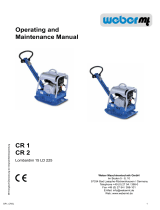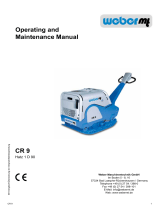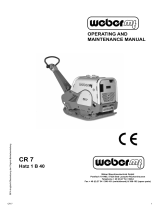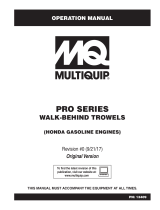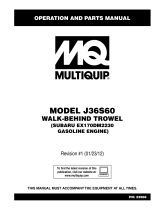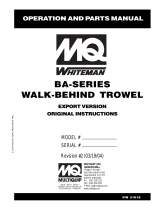Page is loading ...

PG55_110 1
PG 55 BF/70/90/110
Robin-Subaru
1015/englisch/Übersetzung der Original-Betriebsanleitung
Operating and
Maintenance Manual
Weber Maschinentechnik GmbH
Im Boden 5 - 8, 10
57334 Bad Laasphe-Rückershausen / Germany
Telephone +49 (0) 27 54 / 398-0
Fax +49 (0) 27 54 / 398-101
E-Mail: [email protected]
Web: www.webermt.de

2 PG55_110

PG55_110 3
Table of contents
Introduction 4
Safety guidelines 5
Graphic presentation 8
Device description 9
Technical data 10
Activities prior to starting work 12
Starting 13
Troweling 14
Shutting down 16
Maintenance overview 17
Maintenance work 18
Operating uids and ll levels 20
Troubleshooting 20
Storage 21
Contact addresses 23

4 PG55_110
Introduction
This operating and maintenance manual is designed to facilitate familiarization with your concrete
trowel machine, and to enable you to maintain the compactor and use it for its intended purpose.
When complying with the instructions in the operating and maintenance manual you help avoid
hazards, reduce repair and downtime costs, and increase the reliability and service life of your
concrete trowel machine.
This operating and maintenance manual must always be available at the implementation site of
the concrete trowel machine.
If necessary you can obtain additional information from your authorized WEBER dealer, or you
can obtain information from one of the contact addresses on the last page.
You can obtain information on the assembled Robin gasoline engine and nd a spare-part list for
it at www.robin-europe.de.
The valid conformity declaration is enclosed with every machine delivery.

PG55_110 5
Safety guidelines
General
All safety instructions must be read and complied with, non-compliance results in
– Danger to life and limb of the user
– Impairments to the machine or other property.
In addition to the operating manual, the accident-prevention regulations in the country where
the appliance is used must be complied with.
Intended use
The concrete trowel machine should only be used in technically faultless condition, as intended,
in a safety-conscious and hazard-conscious manner, in compliance with the instructions in the
operating manual. Malfunctions that impair safety must be eliminated without delay.
Our PG concrete trowel machines are designed exclusively for troweling
– concrete
– screed.
Any other use of the trowel machine is considered to be non-intended use, for which the customer
is exclusively responsible. All liability is rejected if damage occurs due to non-compliance with this
provision. This risk is borne solely by the user.
Easily foreseeable misuse
Any use for which the machine is not intended.
Operation
Trowel machines are only permitted to be operated by suitable persons of at least 18 years of age.
Operators must be instructed in how to guide the trowel machine by the owner or by owner’s
assigned personnel.
The machine operator must comply with trafc regulations. If instructions that affect safety are
given by third parties, then the operator must be authorized to reject these instructions.
Unauthorized persons are forbidden from being in the area of the trowel machine during the
troweling process.
Protective equipment
This machine is capable of exceeding the permissible sound level of 80 dB(A). The owner might also
face additional dangers when using the machine. Precautionary action must, therefore, be taken.
Hearing protection
Hard hat
Safety shoes
Protective gloves
Protective equipment includes:

6 PG55_110
Operation under difcult conditions
Never inhale the exhaust gas; it contains carbon monoxide, a colorless and odorless gas that
is extremely hazardous, which, if inhaled even briey, can cause unconsciousness and death.
Therefore, never operate the engines in enclosed areas or in areas that are poorly ventilated
(tunnels, caves, etc.). Exercise particular caution when operating the engine in the vicinity of
people and livestock.
Maintenance and repair work
Only use original Weber spare parts to ensure reliable and safe operation for maintenance or
repair work.
Adjusting tasks, maintenance tasks, and inspection tasks must be carried out on schedule as
specied in this operating and maintenance manual. These activities should only be executed
by instructed personnel.
For repair, maintenance, or inspection work the engine of the trowel machine must be safeguarded
against unintentional starting.
All pressurized lines, particularly hydraulic lines and lines of the injection system of the drive
motor must be depressurized before performing maintenance or repair tasks.
For maintenance and repair tasks the trowel machine must be placed on a level and stable substrate
and must be secured from rolling off or tipping over.
Heavy components and assemblies must be secured to and lifted by hoisting machines that can
bear their weight when they are replaced. Ensure that no hazard is caused by raising components
or assemblies.
Do not position yourself or work under suspended loads.
Operation
Prior to starting work the owner of the trowel machine must be familiar with the working environment.
The work environment includes obstacles in the work and trafc area, the bearing capacity of
the ground, as well as the necessary safeguarding of the construction site in the area adjacent
to public trafc; and it includes compliance with trafc regulations.
The trowel machine should only be operated when the protective xtures are mounted.
The protective xtures must all be in functional condition.
At least once per shift the trowel machine must be checked for apparent defects. If there are apparent
defects, then operation of the trowel machine must be stopped immediately, and the responsible
person must be informed. Prior to restarting, trowel machine malfunctions that have occurred
must be corrected.
Always maintain adequate clearance to the edges of pits and embankments.
After work has been concluded, secure the trowel machine in accordance with statutory regulations,
particularly in the area of public trafc surfaces.
If lubricating oils and fuel come into contact with skin, they can cause skin cancer.
Upon contact with the skin, clean affected skin with suitable cleaning agent without delay.

PG55_110 7
Warning against irritants or materials hazardous to health
Warning against a hazardous place
Warning against a suspended load
Wear ear protection
General regulation
Environmental protection
Hard hat
Safety shoes
Protective gloves
Important information for operating and maintenance personnel is marked by pictograms.
Inspection
Trowel machines must be inspected in accordance with appropriate implementation conditions
and operating conditions, as needed; however, an inspection to ensure operationally safe status
must be performed by an expert at least once a year. The results of the inspection must be recorded
in writing and must be stored at least until the next inspection.
Cleaning work
Cleaning tasks should only be executed in areas that are suitable and have been approved for
this purpose (oil separator amongst others).
Disposal
All operating uids and auxiliary materials must be disposed of in an environmentally-compatible
manner in accordance with country-specic regulations.

8 PG55_110
4
7
1
2
8
9
3
5
6
10
Graphic presentation
Overall view PG
1 Engine
2 Protective frame
3 Gas lever
4 Handle
5 V-belt guard
6 Protective cage
7 Troweling blades
8 Adjusting lever / troweling blade adjuster
9 Short-circuit button
10 Hearing protection (sticker)

PG55_110 9
Device description
The trowel machines of the PG series are used in general building construction applications.
Drive
The machine is propelled by an air-cooled Robin-Subaru gasoline engine.
Function
The force generated by the engine is transmitted to the gearbox of the trowel machine by
the centrifugal clutch and a V-belt. The troweling blades and the troweling pan attached to
the gearbox smooth the concrete or screed.
Operation
Start the Robin-Subaru gasoline engine with the attached reversing starter. After starting, the
engine speed is regulated with the gas lever attached to the manual guidance rod. The adjusting
lever tted at the manual guidance rod is used to adjust the angle of the troweling blades.

10 PG55_110
PG 55 BF PG 70 PG 90 PG 100
Vibration values
Root-mean-square acceleration value
for hand-arm vibration ascertained in
accordance with EN 500 in m/s²
Troweling blades, position at 5.9 12.5 12.5 10.4
Troweling blades, position slanted 3.1 8.5 8.5 5.7
In accordance with directive
2006/42/EC, complying with the
vibration values is the owner’s
responsibility.
Technical data
PG 55 BF PG 70 PG 90 PG 110
Weight
Operating weight CECE in kg 53 74 78 95
Dimensions
Overall length (in mm) 1575 2166 2241 2366
Protective ring diameter (in mm) 595 786 936 1186
Height with folded manual
guidance rod (in mm) 900 900 900 900
Operating diameter (in mm) 563 750 900 1100
Drive
Engine manufacturer Robin-Subaru Robin-Subaru Robin-Subaru Robin-Subaru
Type EX 17 D EX 17 D EX 17 D EH 25-2
Performance at operating speed in
accordance with ISO 3046-1 (kW) 3.1 3.2 3.2 5.2
Combustion process
4-stroke gasoline 4-stroke gasoline 4-stroke gasoline 4-stroke gasoline
Operating speed (m/min) 3300 3600 3600 3600
Performance characteristics
Rotation (1/min) 115 120 123 124
Gear ratio 19.5 19.5 19.5 19.5

PG55_110 11
2
1
3 4
56
1 Description 2 TYPE
..................................................................... .....................................................................
3 Serial number 4 Year of construction
..................................................................... .....................................................................
5 Mass 6 Rated power kW
..................................................................... .....................................................................

12 PG55_110
1
2
1
1
Transport
Activities prior to starting work
Arrest the manual guidance rod (1) with the tommy screw (2).
When transporting the trowel machine on a vehicle,
secure it with suitable restraints.
Attach the crane hook (1) to the protective frame and lift
the machine onto the means of transport selected.
Only use lifting machines with a minimum bearing
capacity of 150 kg.
Do not step under suspended loads.
Checking the engine oil level
Pull the oil dipstick (1) out of the crankcase.
Insert the oil dip stick in the oil ller neck, but do not
screw it in.
Open and remove the gas cap (1), check the level, if
necessary top off to the lower edge of the ller neck
with clean fuel in accordance with the specication.
The correct oil level is between the min. and max. marks.
Check the fuel level
For work at the fuel system, have a suitable re-
extinguishing agent at the ready.
Fire, naked light, and smoking is forbidden!

PG55_110 13
1
1
2
1
2
Starting
Turn the short-circuit button (1) to the “ON” position.
Slide the choke lever (1) to the left (close).
Open the fuel cock (2).
After the engine has warmed up, slide the choke lever to
the right (open).
Slowly tighten the handle (1) of the reversing starter (2) until
resistance is noticeable.
Allow the handle (1) to glide back into the initial position, and
then forcefully and completely pull it through with both hands.

14 PG55_110
1
1
1
1
1
Troweling
Use the adjusting lever (1) to set the troweling blade to the
desired position.
Bring the gas lever (1) into full-throttle position.
Only run machine within reach of the manual guidance rod.
Forward
Push the machine forward using the manual guidance rod (1).
Reverse
Pull the machine backward using the manual guidance rod (1).
Move to the left
Lift the machine up slightly using the manual guidance rod (1).
The frictional forces in front of and behind the drive shaft
are increased and decreased, respectively. A clockwise
rotational movement will cause the machine to move to
the left.
Move to the right
Push the machine down slightly using the manual guidance
rod (1).
The machine is caused to move to the right by the shift
of frictional forces at the rear (see above).
Troweling on the spot
Use the manual guidance rod (1) to keep the machine in the
horizontal position.
The frictional forces cancel each other out, causing the
machine to keep moving on the spot.
At obstructions (walls, pits, etc.), ensure that no one can
be caught between the machine and the obstruction; or
ensure that the machine does not slip into the pit.

PG55_110 15
1
2
1
Possible applications
The trowel machine can be used for the machine-assisted troweling of concrete surfaces,
e.g. industrial oors, roller skate rinks, parking decks, sewage plants, basement and garage oors,
screed surfaces, etc.
Pre-troweling
The surface to be smoothed is pre-troweled with
the troweling pan (1).
The right time for pre-troweling has come when a person
walking on the cured concrete surface no longer leaves
footprints behind.
Pre-troweling involves the process of grinding off any
unevenness caused by pouring the concrete and rubbing
the ground-off material into any cavities and recesses that
may exist in the oor.
The concrete surface is leveled. During this process, the concrete surface is compacted
due to a thorough rearrangement of the aggregate particles. Any shrinkage cracks
and pores that may have been brought about by escaping air are sealed. Minimum
size particles shift and settle in the cavities between the larger aggregates. The shifted
particles push any retained water to the surface, where it evaporates.
The number of passes required for pre-troweling cannot be specied exactly as this number
is inuenced by various factors (e.g. concrete consistency, ambient temperature, humidity,
etc.). Under normal conditions, however, one to two passes will sufce.
Fine troweling is applied when no more moisture can be
detected on the surface. For ne troweling the troweling pan
is substituted for the troweling blades.
The troweling blades (1) rotate across the concrete surface (2)
at relatively high pressure and at a certain blade angle (a).
Fine troweling requires that the surfaces have been pre-
treated with the troweling pan.
Fine troweling
It is recommended to use a second trowel machine for surfaces with an area
exceeding 200 sqm.
The rst machine is then used for pre-troweling with a troweling pan.
The second machine is tted with troweling blades and used for ne troweling.
For the rst few passes, the blade angle (a) is usually kept small. The blade angle
increases with the number of passes. A key factor during this process is the weight of the
machine. The wider the angle of the troweling blades and the higher the weight of the
machine acting on the troweling blades are, the harder and, thus, more resistant to wear
the surface is.

16 PG55_110
1
1
1
Shutting down
Close the fuel cock (1).
Turn the short-circuit button (1) to the “0” – OFF position.
During breaks – even if they are short – the machine
must be shut down.
Parked devices that represent an obstacle must be
safeguarded against through conspicuous measures.
Press the short-circuit button (1).

PG55_110 17
Maintenance overview
The regulations of the engine manufacturer must be complied with in addition to the above main-
tenance overview!
Work must be carried out using regulation tools, and the operating and maintenance manual must
be complied with for all work.
All maintenance work: Select a collection vessel that is large enough to prevent oil from spill-
ing onto the ground. Dispose of waste oil in an environmentally friendly manner (regulation
on waste oils).
Dispose of oils, greases, cloths soaked in oil, and replaced parts with oil on them in an
environmentally friendly manner.
If lubricating oils and fuel come into contact with skin, they can cause skin cancer.
Upon contact with the skin, clean affected skin with suitable cleaning agent without delay.
If accessible during maintenance, check the condition and stability of all screws.
Maintenance interval Maintenance
point Maintenance activity
After the rst 25
operating hours
Engine - Change engine oil
-Re-tighten all accessible
threaded connections
Every 8 operating
hours/daily Air lter -
Clean air lter insert, check
for damage, replace if
necessary
Every 150 operating
hours/every 6 months Engine - Change engine oil
Every 150 operating
hours/every year
Engine - Change oil
- Adjust valve play
-Clean spark plug and
adjust electrode gap
Every 300 operating
hours
Gearbox - Change semi-uid grease

18 PG55_110
1
1
1
2
When working in the area of the engine compartment
there is a danger of being burnt!
Remove the oil drain screw (2) and drain oil.
After emptying completely, put in the locking screw (1).
Fill with oil in accordance with specications.
Maintenance work
Change the engine oil
Remove the oil dip stick (1).
Only drain engine oil when at operating temperature.
Danger of scalding due to hot oil.
If lubricating oils and fuel come into contact with skin,
they can cause skin cancer. Upon contact with the skin,
clean affected skin with suitable cleaning agent without
delay.
Clean / change air lter cartridge
Unscrew the air lter cover (1).
Remove the air lter insert (1) from the air lter enclosure.
Clean air lter insert as specied by the engine manufacturer
if there is damage or if it is extremely dirty.
Dispose of oils, greases, cloths soaked in oil, and
replaced parts with oil on them in an environmentally
friendly manner.

PG55_110 19
1
1
Checking the V-belt
Remove the V-belt guard (1).
Check the V-belt (1) for cracks, damaged anks, and wear.
If there is excessive wear – replace the V-belt as specied in
the repair manual.

20 PG55_110
Operating uids and ll levels
Assembly Operating material Quantity Quantity
Summer Winter
PG 55 BF
PG 70
PG 90
PG 110
Quality
Engine
Engine oil
SAE 10 W 40
(– 10 ~ + 50 °C)
API – CD CE
or SHPD
or CCMC – D2 – D3 – PD1
0.6 l 0.6 l
Fuel tank
Gasoline
Regular unleaded gasoline 3.6 6.0
Worm gear Semi-uid grease Grease 00
Mobil Glygoyle
0.9 0.9
Troubleshooting
Fault Possible cause Remedy
Machine does not
start
Operating error Execute start process as prescribed
Lack of fuel Check the fuel level
Fuel lter fouled Change the fuel lter
Air lter fouled Clean / change air lter cartridge
No vibration / no
forward motion or
insufcient forward
motion
Vibrator V-belt
defective
Change vibrator V-belt
/




